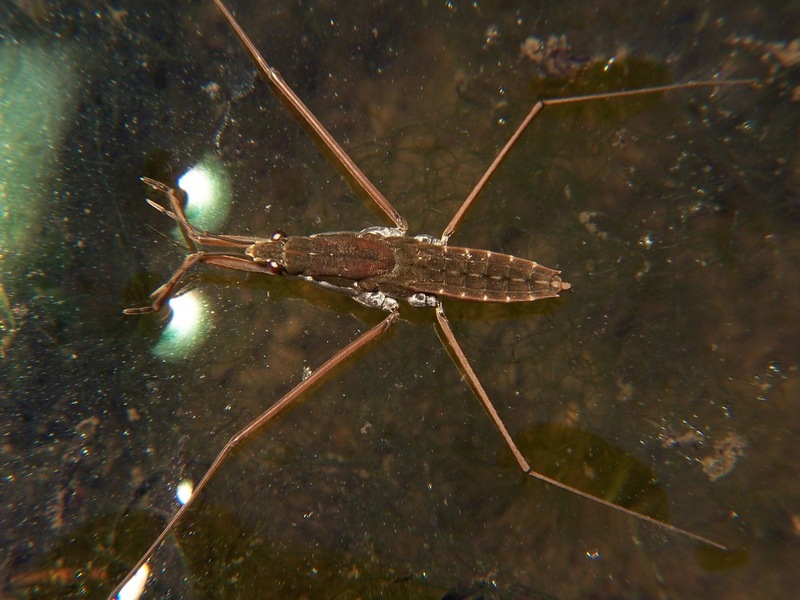Water Strider (Family: Gerridae) - Wiki Gerridae
From Wikipedia, the free encyclopedia
[Photo] adult water strider, Gerris remigis. Order Hemiptera / Suborder Heteroptera / Infraorder Gerromorpha / Superfamily Gerroidea Family: Gerridae (Leach, 1815) -- water striders / Genus: Gerris (Fabricius, 1794). Source: http://www.cirrusimage.com/bugs_water_strider.htm Date 07/08/2005. Author Bruce J. Marlin
The family Gerridae contains insects commonly known as water striders, water bugs, magic bugs, pond skaters, skaters, skimmers, water scooters, water skaters, water skeeters, water skimmers, water skippers or Jesus bugs. These are predatory insects which rely on surface tension to walk on top of water. They live on the surface of ponds, slow streams, marshes, and other quiet waters. They can move very quickly, up to 1.5 m/s.
"Five species of Halobates sea skaters are the only insects that have successfully colonized open ocean habitats. H. micans populations from the Pacific, Atlantic and Indian Oceans have been isolated for 1 to 3 million years".
Propulsion Method
Animals such as water striders that live on the surface of water need to push something backwards to generate a reaction force (that is, Newton's third law of motion).
It was originally thought that water striders transferred momentum to the water by the creation of capillary waves on the surface. However, biophysicist Mark Denny showed that to do this, some object must move faster than about 0.25 m/s???far faster than a water strider can move its legs. This apparent contradiction is known as Denny's paradox.
Water striders beat Denny's paradox by generating not capillary waves but hemispherical vortices in the water. These vortices carry sufficient backwards momentum to propel the animal forwards.
In a series of experiments, mathematician John W. M. Bush and several graduate students showed that during the rowing stroke, water striders drive their middle legs backwards without penetrating the surface, and can attain speeds of up to 1.5 m/s.
Besides skating on the surface of water, adult water striders can also use wings (e.g. to fly to another body of water).
Nature of the hydrophobic legs of a water strider
Water striders can stand effortlessly on water due to their non-wetting legs. Writing in Nature, biophysicists Xuefeng Gao and Lei Jiang show that the water resistance of the legs is due to the "special hierarchical structure of the legs, which are covered by large numbers of oriented tiny hairs (microsetae) with fine nanogrooves". They go on to demonstrate that the water resistance is due more to this physical structure than the chemical properties of the wax coating of the legs.
Gao and Jiang calculate the maximal supporting force of a single leg to be is 1.52 millinewtons (152 dynes or 0.011 poundal), which is about 15 times the total body weight of the insect. This shows that the surface of the leg is strikingly water repellent.
For comparison, Gao and Jiang made a hydrophobic 'leg' from a smooth quartz fibre that was similar in shape and size to a strider's leg. Its surface was coated with a thin layer of heptadecafluorodecyltrimethoxysilane (FAS-17), whose contact angle with water is 109°. However, this artificial leg supported a force of only 0.19 mN (19 dyn or 0.0014 pdl): this would be just about enough to support the strider at rest, but not to enable it to dart around rapidly on the surface.
Gao and Jiang went on to calculate that the contact angle with water on a real strider's leg would be greater than 150° (and described this using the neologism 'superhydrophobic') and, using a sessile water-drop showed that the contact angle of the insect's legs with water was 167.6° ± 4.4°.
They went on to infer that the observed superhydrophobicity was due to microstructures on the legs and, using a scanning electron microscope, showed that the legs were covered in many needle shaped setae, with diameters ranging from 3 micrometres down to a few hundred nanometres. Most of the setae were about 50 micrometres long and were at an angle of about 20° from the surface of leg. Each microseta also had nanoscale grooves, contributing to the hierarchical structure of the leg.
Gao and Jiang used Cassie's law to show that air is trapped in spaces in the microsetae and nanogrooves, forming a cushion at the leg???water interface. This cushion prevents the legs from being wetted.
Genera
Aquarius
Eotrechus
Gerris
Halobates
Limnogonus
Limnoporus
Metrobates
Neogerris
Rheumatobates
Trepobates
http://en.wikipedia.org/wiki/Gerridae
| The text in this page is based on the copyrighted Wikipedia article shown in above URL. It is used under the GNU Free Documentation License. You may redistribute it, verbatim or modified, providing that you comply with the terms of the GFDL. |
